The first future MOLby John B. Charles, Ph.D.
|
| MOL’s persistence in the public imagination seems rooted in its secret life and premature death, nurtured by a few well-known but speculative illustrations, some of which have been overlooked while hiding in plain sight. |
A military follow-on was considered a certainty in some quarters. Although there was no approved MOL program beyond the planned seven-flight R&D effort, an aerospace trade journal in early 1966 quoted an unidentified “high-ranking [Air Force] official” as saying that “we wouldn't have started the program if we didn't have plans for an operational system.”[3] In fact, there have been multiple distinct versions of such plans described in the public literature and in the NRO documents declassified in October 2015[4] and subsequently (for example, see “The last spacemen: MOL and what might have been,” The Space Review, November 16, 2015.)
The paintings in the AFAC represent an earlier vision of a future operational MOL program. It started with what is probably the most famous illustration of MOL (Figure 1) as featured in the August 1965 press announcement. It had already appeared on the cover of a trade periodical, GSE Magazine, in early 1965, and reportedly elsewhere as early as June 1964,[5] and has been reproduced countless times over the succeeding decades: if you have only ever seen one picture of MOL, this is probably it.
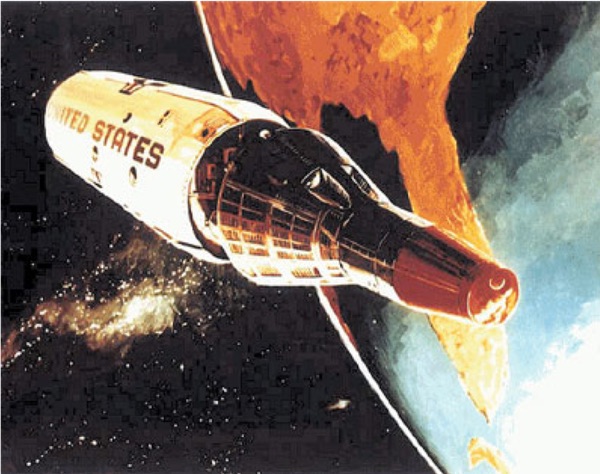 Figure 1. Title unknown, presumed by Richard Schlect based on image similarity with Figure 2 which is officially credited to Schlect. This is the classic image of MOL in orbit first published in 1964. It does not appear in the Air Force Art Collection listings. (Credit: USAF.) |
The artist is not credited, but I believe it was Richard Schlect for reasons described below. Googling produced no biographical information on Schlect, but his last name is a variant of the German word for ‘bad,” as in both “precarious” and “nasty,” which suggests a colorful family history. The MOL and its attached Gemini crew capsule are depicted in the common style for spacecraft illustrations of that era: illuminated at an angle by an early-morning sun, passing low over easily recognizable Florida.
Your eye is drawn to the Gemini capsule, already familiar in 1964 as NASA’s next manned spacecraft. In this illustration, it has oddly close-set windows and an oversized red nose section. The MOL version was designated Gemini-B (NASA’s was never called “Gemini-A” as far as I know) and is the most detailed and commanding aspect of the image despite being, arguably, the less important part of the combined vehicle.
The more important part is MOL itself. It is in the background, partially obscured by the Gemini. It is a long white cylinder, nondescript except for the large “United States” in bold black octagonal font longitudinally along its right flank bracketed by two star-and-bars roundels; presumably, the markings were repeated on the left side. The cylinder shows only insignificant portholes, wholly inadequate for reconnaissance, and no other indications of any military mission—as befits a publicity image of a classified military spacecraft.
The Gemini is separating from the MOL, which would only occur at the end of its month-long mission. In later design concepts, the Gemini-B was shown with its deorbiting retrorockets in an adapter module between the capsule and the MOL. In this early concept, the adapter module is that ambiguous conical segment between the Gemini and the MOL, and importantly it is not attached to the departing Gemini. Schlect might have been advised that Gemini-B’s retrorockets would be mounted directly to its heat shield, like on Mercury, as seen in a few very early MOL illustrations.
Schlect’s 1965 version formed the basis of a glowing vision of future MOL operations that was incrementally revealed in five images published over the next two and a half years in the October 1965,[6] October 1967,[7] and March 1968[8] issues of the Air Force and Space Digest,[9] the monthly publication of the Air Force Association.[10] Three MOL vehicles yoked side-by-side like oxen were the basic unit of a permanent American military manned presence in orbit. It would have had two primary goals: shepherding flocks of unmanned photographic and radar reconnaissance satellites and tending large inflatable dish antennas aimed Earthward for signals intelligence. Dwayne Day described an unsuccessful attempt to operate an experimental inflatable antenna system mounted on an Agena satellite in 1964,[11] which might have inspired both the art and the article.
Unfortunately, Figure 1 is not in the Air Force Art Collection,[12] although it clearly should be. The collection’s website permits searches by artist, title, and topic: Schlect is listed among the artists and is credited with a related image that shares distinctive features with Figure 1, so I posit that Figure 1 was by him, too.
| Schlect’s triple-MOL scenario clearly placed accuracy secondary to visual drama. |
Those five images, plus one more available only at the Air Force Art Collection and its website (four of which are linked in the NARA website), are all absent from the tranches of declassified NRO documents released in October 2015.[13] In fact, three of the six images appeared only at the art collection website and in the Air Force and Space Digest articles and nowhere else. The two images from 1965 are also in an online space history article[14] about the Soviet Union’s version of the MOL program, and have occasionally been used as generic representations of MOL. The six images in the Air Force Art Collection are only in black and white.
The October 1965 issue first revealed Schlect’s triple-MOL configuration (Figure 2), based on his basic vehicle, including the same Gemini with its close-set windows and the generic MOL. The Air Force Art Collection gives its title as “USAF’s MOL” and credits it to Richard Schlect.[15]
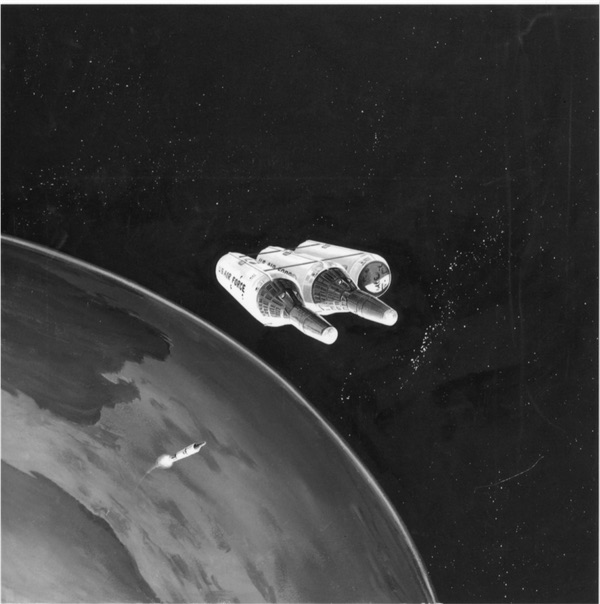 Figure 2. “USAF’s MOL” by Richard Schlect published in Air Force and Space Digest, October 1965, both on the cover and on page 39. The original painting is listed as on display in the Pentagon, 4th floor, E-ring, 9-10 (see Figure 9). (Credit: USAF and US Air Force Art Collection, February 1, 2016); thumbnail only at http://www.russianspaceweb.com/almaz_origin.html, accessed February 20, 2016. Also here, accessed June 23, 2019.) |
In the sky over Florida’s Atlantic coast (again), two Gemini capsules are firmly attached to their MOL host vehicles, but a third MOL is missing its Gemini, presumably having safely returned its crew to Earth. Technical details like how the cylindrical modules were to be linked for the astronauts to move between them are left to the viewer’s imagination. The nondescript MOL forward bulkhead shown in Figure 2 is consistent with the small section of it visible in Figure 1. A circular feature in the center of that bulkhead may represent the internal transfer tunnel between the Gemini-B and the MOL.
The triple-MOL is depicted with considerable artistic license, especially as regards the fourth vehicle being boosted into orbit. The Titan III launch vehicle’s two solid rocket “stage zero” boosters have already been jettisoned and its first stage is shown firing, an action that, in reality, would occur nearly a hundred miles below orbital altitude. By the time the vehicle had reached orbital altitude, it would have been reduced to just the Gemini and MOL modules and would be closing in for rendezvous and travelling in a path parallel to the orbital base, not perpendicular to it. Thus, Schlect’s triple-MOL scenario clearly placed accuracy secondary to visual drama.
In its caption for this figure, the magazine stated that MOL’s main objective—to determine man’s ability to perform complex operations in space—would produce great masses of land, sea, and air reconnaissance data requiring rapid interpretation and timely relay of critical information into the Department of Defense command and control network. Therefore, the only way for MOL to be effective as the highest ground available to the military would be for it to:
“…carry many cameras, infrared devices, radar and other electronic reconnaissance devices, computer-operated data interpretation and recording aids, plus data links and voice communications equipment to maintain contact with the ground. Sizable power supplies must be available for such equipment, and any space station which houses it all must be quite large. A single MOL vehicle does not have the capacity: its maximum allowable weight is 25,000 pounds [11,000 kilograms], of which 20,000 pounds [9,100 kilograms] must be devoted to the crewmen, their life support systems and their reentry vehicle. The 5,000 pounds [2,300 kilograms] remaining for experimental equipment is far short of what is needed to make the MOL into an effective reconnaissance and command and control vehicle. Four MOLs docked together probably would do the job in revolutionary fashion. If only a four-man crew were kept in this four-MOL station, its equipment payload probably could be boosted above 50,000 pounds [23,000 kilograms].”[16]
| In our only glimpse inside a triple-MOL station, Phillips has two Air Force astronauts operating a complex set of instruments at a workstation complete with steam gauges and weightlessness-appropriate minimalist chairs. |
Thus, the magazine stipulated quadruple MOLs as the minimum useful set, even though only triple-MOL assemblages appear in the accompanying images. (A four-man, three-MOL station could presumably accommodate 35,000 pounds [16,000 kilograms] of reconnaissance equipment.) Perhaps the art preceded and even inspired the articles. The magazine repeated the Air Force’s assertion that it had no firm plans for rendezvous and docking, but then immediately propounded a program that would have required the simultaneous orbital docking of half of all the MOL vehicles that the Air Force had been authorized to build and fly sequentially over the entire two-year test program.
The multi-MOL assemblage was not seen again for two and a half more years, until the March 1968 issue.[17] In it, the third and last article in the series depicted the cluster shepherding a flock of unmanned reconnaissance satellites (Figure 3). This and the remaining four MOL images in the set were painted not by Schlect but by Gordon Phillips but were clearly derived from Schlect’s initial concept.
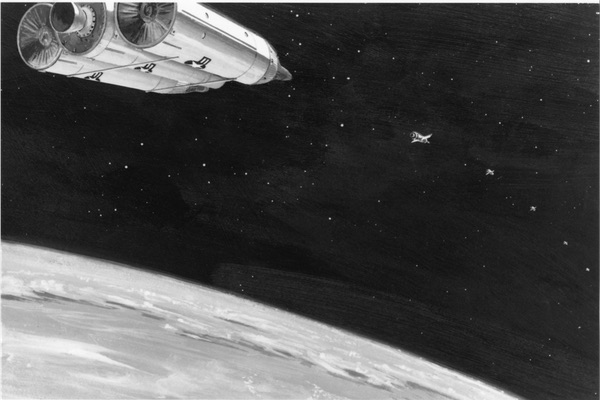 Figure 3. “Orbital Vehicle” by Gordon Phillips, published in Air Force and Space Digest, March 1968, p. 47. The original painting is listed as on display at Maxwell AFB, Montgomery, Alabama. (Credit: Air Force and Space Digest and US Air Force Art Collection, accessed February 1, 2016. Also here, accessed June 23, 2019.) |
Phillips showed a manned station formed by joining three MOLs, two with Gemini-like Mylar thermal insulation over presumably open aft ends. The third, central MOL has an impossibly large rocket nozzle for the considerable maneuverability required to marshal its group of unmanned reconnaissance satellites, such as those in the queue of five shown stretching into the distance at right on solar panel wings. According to the magazine, formations of these satellites would permit new techniques, such as computers using radar returns from several precisely spaced vehicles to produce photographic-quality images showing objects on the ground no more than one foot in diameter.
Phillips retained Schlect’s simple color scheme for MOL so the images may be considered a coordinated set, but he improved the adapter section between the Gemini and the MOL.
The caption in the March 1968 issue for the image in Figure 3 and the accompanying article’s text stipulated a fleet of 100 or more unmanned low Earth orbit satellites, each solar powered and weighing about 10,000 pounds (4,500 kilograms). They would provide continuous “live” global coverage defined as a 75 percent probability of being over any location every 30 minutes, monitoring a few trouble spots almost constantly and the rest of the globe intermittently.
These unmanned satellites would generate information continuously, and, according to the article, the crew aboard the associated manned station would use computer-driven display equipment to filter and discard large quantities of unnecessary data to reduce transmission volume to the ground. This matches the announced primary task of the planned MOL R&D program. In our only glimpse inside a triple-MOL station, Phillips has two Air Force astronauts operating a complex set of instruments at a workstation complete with steam gauges and weightlessness-appropriate minimalist chairs (Figure 4). The middle MOL’s Gemini spacecraft has apparently already departed, judging by the missing Gemini-type adapter section between those of the near and far MOLs.
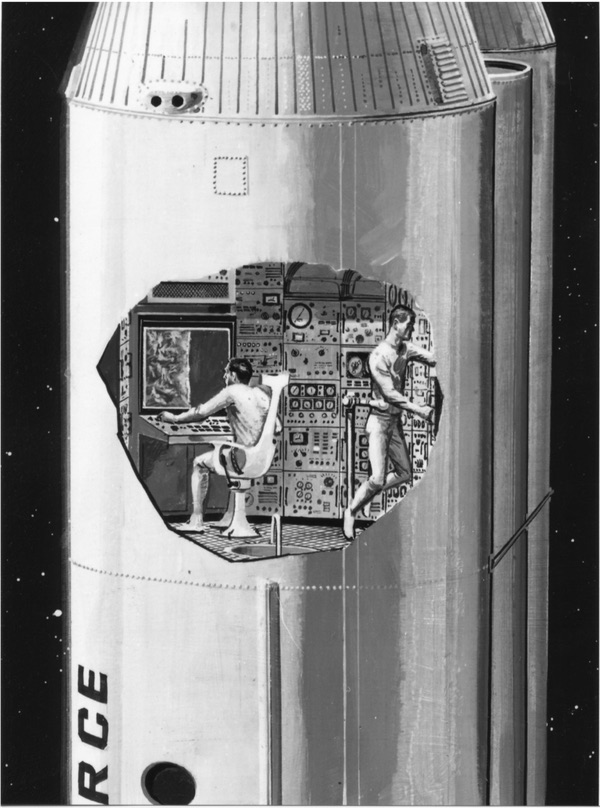 Figure 4. “Live Reconnaissance” by Gordon Phillips, published in Air Force and Space Digest, March 1968, p. 47. The original painting is listed as on display at the US Air Force Academy, Colorado Springs, Colorado. (Credit: US Air Force Art Collection, accessed February 1, 2016. Also here, accessed June 23, 2019.) |
The magazine suggests that four such triple-MOL stations would be require to support the constellation of one hundred free-flying satellites. Thus, when not sifting raw data for pearls of intelligence to transmit to the ground, the men would perform the required yearly maintenance of the self-repairing electronics in their 25 assigned satellites—a different satellite every two weeks, on average. The magazine asserted that this would cut the cost of the satellite constellation in half, but did not estimate how much of the savings would go to pay for the continuing operations of the four manned multi-MOL stations.
The final three images in the set, all by Phillips, depict an even more extensive infrastructure for the Air Force’s MOL-based future as foreseen by Air Force and Space Digest. First, according to unnamed Defense Department officials cited by the magazine, a single MOL would assemble and check out a hundred-foot (30-meter) parabolic dish antenna for radio communication and radar surveillance (Figure 5).
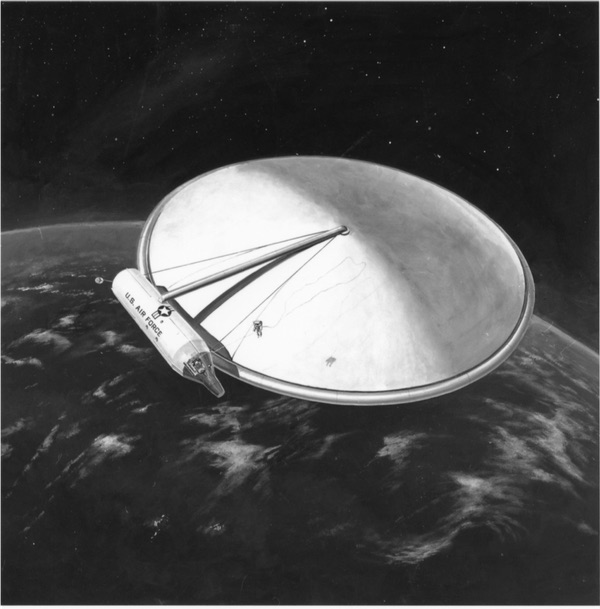 Figure 5. Title unavailable, by Gordon Phillips, published in Air Force and Space Digest, October 1965, pages 44–45. It is not currently listed as on display. (Credit: Air Force and Space Digest but not US Air Force Art Collection; thumbnail only at RussianSpaceWeb, February 20, 2016.) |
The parabolic antenna would have been stowed in a container on the side of the MOL for launch, then inflated in orbit and rigidized using quick-setting plastic foam. The Air Force astronaut who rigged the antenna is shown returning to the open hatch of his Gemini, which is apparently serving as his airlock into the shirtsleeve MOL. He is using the Astronaut Maneuvering Unit (AMU) backpack developed by the Air Force and ultimately flown on Gemini 9 but not successfully tested; a hundred-foot safety tether lazily marks his path to the center of the dish antenna and back in a decidedly untether-like manner.
| The magazine suggests that four such triple-MOL stations would be require to support the constellation of one hundred free-flying satellites. |
An article in the October 1965 issue waxed enthusiastic over such a prospect. It noted that a large antenna of this type would greatly reduce the power required for high-resolution ground surveillance and for wide band communications with ground stations. This antenna was to be the largest of dozens carried on the MOL, which, according to the article, would have bristled with all types of sensing gear, although only one dish antenna perhaps three feet (one meter) in diameter is seen in any of the images. Arrays of small antennas were to be grouped along the sides of the MOL canister, adding up to even more effective area than the 7,850 square feet (730 square meters) of the large dish. Infrared domes dotting the MOL, along with cameras and radar, would have allowed MOL to observe air, sea, and land activity seamlessly through daylight and darkness, regardless of cloud cover.
The inflatable dish would be the nexus for a growing space surveillance center (Figure 6, unpublished and appearing only in the Air Force Art Collection.) A second MOL has been added, and an astronaut is inspecting the dish during an EVA, again using the Gemini as an airlock.
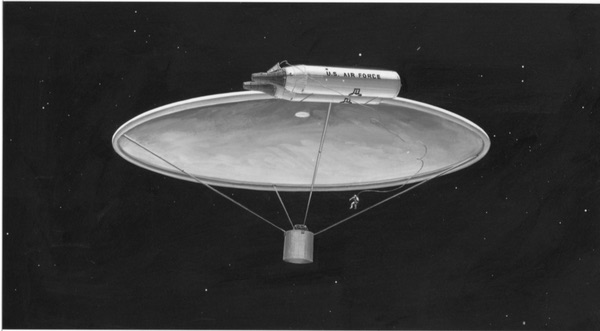 Figure 6. “Reconnaissance Tomorrow” by Gordon Phillips, not published in Air Force and Space Digest along with the others in the series but the original painting is listed as on display at Los Angeles AFB, Los Angeles, California. (Credit: US Air Force Art Collection; February 1, 2016. Also here, accessed June 23, 2019.) |
The concept was further developed in the October 1967 issue (Figure 7). In this image titled “AFB [Air Force Base] In The Sky,” conjoined MOLs would provide living space and housing for equipment in a future U.S. space base of 1975. They would permanently tend the inflatable dish antenna, presumably in addition to their assigned flock of co-orbiting unmanned reconnaissance satellites.
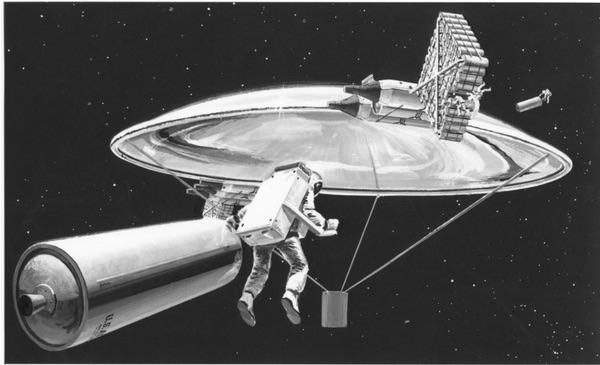 Figure 7. “AFB in the Sky” by Gordon Phillips, published in Air Force and Space Digest, October 1967, cover and p. 84. (Credit: US Air Force Art Collection, accessed February 1, 2016.) |
These images appear to show the same parabolic dish from the same angle, the only differences being the added supporting infrastructure. But Phillips changed the dish itself by simplifying the structure of the feed antenna as well as removing one of its supports (four in Figure 6 but only three in Figure 7). This suggests some revision in artistic direction from the corporate or government sponsor, perhaps as the actual design was refined during the interval between the paintings, or again through artistic license.
Triple-MOLs made for an ambitious goal, but the most extreme—and ironically appropriate for a military project—aspect arose in how resupply would be handled (Figure 8). Air Force and Space Digest foresaw the day when small canisters fired from 36-inch (0.9-meter) diameter guns[18] on Earth would put 2,000-pound (900-kilogram) payloads into orbit for as little as one-tenth the cost of rockets.
| That 1965 article predicted satellite reconnaissance in five years would be much improved. This proved true but only for unpiloted satellites, which did not bother detecting targets, whether moving or stationary, or discarding unnecessary data. |
Those guns were at the core of the innocuously named “High Altitude Research Project,” a joint undertaking of the United States Department of Defense and Canada’s Department of National Defence. It had the ostensible goal of studying the ballistics of re-entry vehicles for intercontinental ballistic missiles using a low-cost method based on a very large gun to fire the models to high altitudes and speeds, instead of expensive and failure-prone rockets.
The picture’s caption stated that HARP “has established that large cannon have the capacity to send payloads into orbit at exceptionally low cost, perhaps one-tenth the cost of large rockets. The sixteen-inch gun […] was made by mounting the barrels of two naval cannon together. It is being used on Barbados. Several US aerospace firms are interested in further [HARP] experiments. Studies show that guns firing rocket-boosted payloads up to forty inches in diameter could be made inexpensively. They would be made from steel sleeves reinforced by glass fiber and other new materials, rather than forged from giant steel billets.”
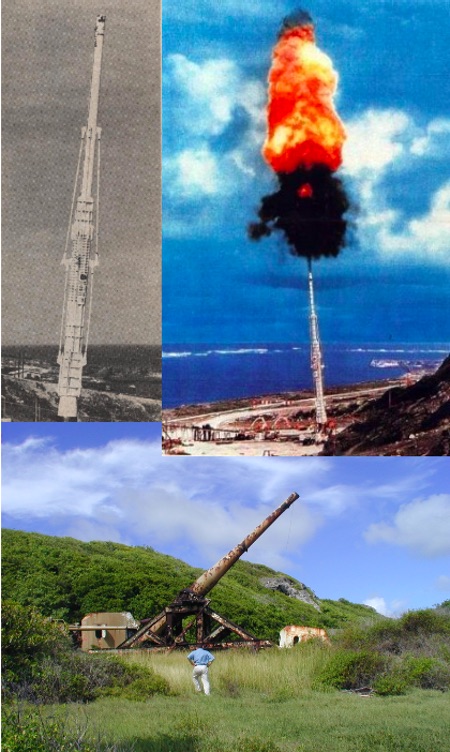 Figure 8. “Project HARP.” The image on the left was published in Air Force and Space Digest, October 1967, p. 88. The image on the right was published on-line in “Project HARP Space Gun,” Atlas Obscura, accessed October 21, 2016. The bottom image was taken in 2000, courtesy of Mike Jenne. |
HARP lost its Defense Department funding in 1966, but that did not prevent Air Force and Space Digest from making the defunct project an integral part of its envisioned MOL-based permanent space stations in the second article in this series a year later. Phillips depicted the triple-MOL, again minus the middle Gemini spacecraft, as the target for 80 of those gun-launched canisters, including two being towed into position by AMU-propelled pilots to be mounted in the support frame by two other pilots. Another triple-MOL is visible on the opposite edge of the dish, with all three Geminis still attached, adjacent to another 80-canister resupply depot. Thus, this single picture posited an orbital facility with six MOLs supported by 160 tons (145 metric tons) of cannon-fired supplies and ten Air Force astronauts onboard to operate and maintain it. The large stock of rocket propellants being accumulated would allow the station to maneuver, perhaps to refuel its flock of unmanned satellites as well as to intercept a variety of ground targets from orbit. The magazine did not indicate how many of these hexa-MOL orbital installations would be needed for the desired level of radio surveillance, but even a single such installation in orbit would require a substantial on-going investment, even with inexpensive gun-launched resupply.
As is unfortunately the case with much 1960s corporate aerospace art,[19] the seven images in this set (two by Schlect and five by Phillips) are not dated or signed. Happily, the Air Force and Space Digest and the Air Force Art Collection insist on identifying and acknowledging the artists, saving them from undeserved obscurity.
Schlect’s iconic single-MOL image was published on the cover of an obscure trade journal in early 1965 and was apparently published elsewhere in mid-1964, then republished extensively after the presidential authorization for MOL to proceed in August. Figure 7 by Phillips can be dated to no earlier than mid-1965 by the configuration of the AMU. It is possible that Schlect produced the two images in Figures 1 and 2 in 1964 and then moved on to other tasks, and that Phillips produced the remainder in 1965. Nonetheless, all the artwork in the three articles was probably in hand by autumn of 1965. I have been told that this volume of output was routinely generated in corporate art departments within a few weeks or less. If so, it must have been husbanded to accompany articles expected over the next two and a half years, and at least one image (Figure 6) never even made it into publication.
In addition to its impact on orbital reconnaissance, a manned spaceflight project of the scope in these images would have had a tremendous influence on space medical research. The MOL program baselined in 1965 promised up to five 30-day missions by two men each, at a time when the worldwide experience barely totaled 75 person-days. A single mission of the “AFB In The Sky” would have orbited ten men for at least 30 days and probably longer, making it a tremendous opportunity for extended physiological investigation. Air Force and Space Digest noted[20] that medical experimentation was an important item in the upcoming MOL plans, but the basic MOL design was already dictated by astronaut flight experience and Air Force ground experiments that showed that man probably would be able to function for long periods in weightlessness. If spinning were needed to produce artificial gravity, the magazine observed that MOL would have to have been redesigned, requiring a long delay in its flights.
In reality, the MOL design matured and its mission constricted in 1967 and 1968, while concepts for a follow-on program took a different direction.[21] The persistence of these articles in Air Force and Space Digest based on the artwork of Schlect and Phillips and the already-discontinued HARP guns suggests that the magazine’s editorial direction was disconnected and agenda-driven, at least on this topic.
Even in October 1965, Air Force and Space Digest noted that the technologies of all of these systems were progressing rapidly. Moving-target detection units, image-amplification systems, upgraded antennas, and microminiaturized computers and electronics, with their lower power requirements, were quickly being upgraded. As those systems improved, the magazine promised, so would the prospects for fleets of operational MOL vehicles with their crews busily filtering and discarding large quantities of irrelevant data to reduce transmission volume to the ground.
That 1965 article predicted satellite reconnaissance in five years would be much improved. This proved true but only for unpiloted satellites, which did not bother detecting targets, whether moving or stationary, or discarding unnecessary data. Instead, they carried large amounts of film and exposed it whenever there was a reasonable opportunity to photograph a designated ground target. The filtering and discarding were left to non-astronaut analysts safely and economically down on Earth. This eliminated the need for military “astrospies” and led to the cancellation of MOL before it could ever fly.
As MOL faded, so did the grandiose operational system of multi-MOL stations so confidently predicted in Air Force and Space Digest. We are fortunate to have these articles and this artwork to serve as a reminder that the need for reconnaissance evolves but doesn’t disappear and that the methods for providing it improved faster and ultimately better than anticipated.
Acknowledgments
The author thanks Dr. Dwayne Day, noted space reconnaissance historian, and Dr. Mark Lewis, Chief Scientist of the US Air Force, 2004–2008, for contacting Dr. R. Fletcher Davis, Director of Operations for the US Air Force Art Collection, who arranged the visit to the Air Force Art Collection in the Pentagon.
The professionalism, thoughtfulness and patience of Russell Kirk and Gregory Thompson in accommodating the author during (Figure 9) and after the Pentagon visit are greatly appreciated.
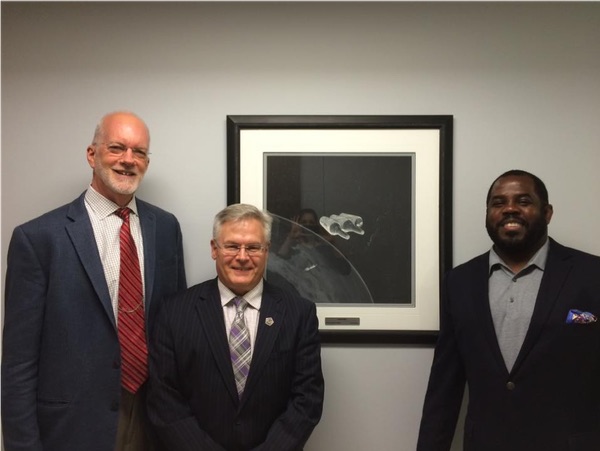 Figure 9. The author, Russell Kirk, and Gregory Thompson with Phillip’s “USAF’s MOL” in the Pentagon, May 12, 2016. |
The author also thanks the anonymous and somewhat nervous Pentagon employee who happened to be passing by as we examined Schlect’s “USAF’s MOL” in the Pentagon’s E-ring. She good-naturedly took one photograph but then, apparently concerned by the appearance of clandestine activity in this high-security environment, almost tossed the camera phone to us as she hurried away.
Finally, the author thanks Dr. Day and Mr. Mike Jenne, author of the Blue Gemini trilogy, for thoughtful editorial recommendations on an early version of this manuscript.
Endnotes
- “The United States Air Force Art Collection”, (accessed Oct. 13, 2016).
- UMDArchives, “University Archives takes a trip to the Pentagon & the Air Force Art Program,” Jan. 21, 2015, (accessed Oct. 13, 2016).
- Taylor, Hal, “Future Programs Considered Hinged to MOL Performance,” Missiles & Rockets, May 30, 1966, p. 32.
- NRO MOL documents (accessed June 25, 2019).
- Wunder, Charles C., Life Into Space: An Introduction to Space Biology, F.A. Davis, Philadelphia, 1966.
- Leavitt, William, “MOL: Evolution of a Decision,” Air Force and Space Digest, vol. 48, no. 10, October 1965, pp. 35-41; Butz, J.S., Jr., “MOL: The Technical Promise and Prospects,” Air Force and Space Digest, vol. 48, no. 10, October 1965, pp. 43-46.
- Butz, J.S., Jr., “Crisis in the Space Program,” Air Force and Space Digest, vol. 50, no. 10, October 1967, pp. 83-88.
- Butz, J.S., Jr., “New Vistas in Reconnaissance from Space,” Air Force and Space Digest, vol. 51, no. 3, March 1968, pp. 46-56.
- Space Digest began as a special section in Air Force Magazine in November 1958, and proved so popular that it was part of the magazine's title—Air Force and Space Digest—from June 1959 until January 1971. During the 1960s, the magazine was frequently critical of the Johnson administration’s prosecution of the war in Vietnam, and vocal in its opposition to both global Sino-Soviet hegemony and the encroachment of the other armed services on the proper domains of the US Air Force. Judging from the text and photograph captions for those three articles, its editorial policy may have been to interpret established facts to provide the most compelling support for a predetermined position.
- The Air Force Association is a non-profit, independent, professional military and aerospace education association promoting public understanding of aerospace power and the pivotal role it plays in the security of the nation.
- Day, Dwayne, “STRAWMAN: The Deep Black Signals Intelligence Satellite,” Spaceflight vol. 59, no. 2, February 2017, pp. 62-65.
- The United States Air Force Art Collection, (accessed July 31, 2016).
- NRO MOL release
- Zak, Anatoly, “Spacecraft: Manned: Almaz: Origin,” Russian Space Web, (accessed Nov. 30, 2015). See picture gallery.
- The Air Force Art Collection website has a URL for an image with that title that it credits to Schlect, but instead of the image, it has only text reading “image not available.” However, this very image is, in fact, on display in the indicated location in the Pentagon.
- Leavitt, William, “MOL: Evolution of a Decision,” Air Force and Space Digest, vol. 48, no. 10, October 1965, pp. 35-41. Caption of illustration on p. 39.
- Butz, J.S., Jr., “New Vistas in Reconnaissance from Space,” Air Force and Space Digest, vol. 51, no. 3, March 1968, pp. 46-56.
- “Project HARP,” (accessed Feb. 21, 2016).
- Prelinger, Megan Shaw, Another Science Fiction: Advertising the Space Race 1957–1962, Blast Books, 2010.
- Leavitt, William, “MOL: Evolution of a Decision,” Air Force and Space Digest, vol. 48, no. 10, October 1965, pp. 35-41. Caption of illustration on p. 39.
- “Application of MOL Hardware for Rendezvous/Resupply Operating Mode,” Contract (draft), March 1967, (accessed Mar. 8, 2016).
Note: we are temporarily moderating all comments subcommitted to deal with a surge in spam.